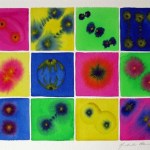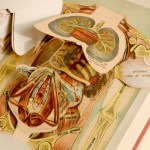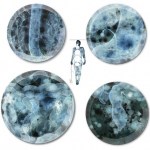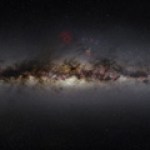Science
here we go again...
this is the map of earthquakes in the last 24 hours in Iceland,
kinda lit up there - nice illustration of the mid-atlantic ridge coming up from the south and south-west and bisecting the island
so that little cluster under Vatnajökull, that is Grímsvötn
Grímsvötn is a sub-glacial lake; also a significant extremophile site and of interest to astrobiology.
There is a volcano there, under the ice, and it is warm enough to continuously melt the ice, forming a lake; every few years the water pressure becomes high enough to break out from under the ice, giving us a jökulhlaup…
Cell Division IV
Michele Banks
DC area artist Michele Banks has donated one of her cell division watercolors to raise funds for art outreach. Check out the online auction - the painting is matted and framed and currently going for only $52.
Michele is not a biologist, but she's been on a sci-art kick for a while, inspired by the fortuitous resemblance of watercolor patterns to cellular structures. To see more of her work, visit her etsy shop, artologica.
A CSPO webcast entitled "New Tools for Science Policy" asks an interesting, if somewhat odd, question about science and art: "Can art and religion serve as methods for governing emerging science and technology?"
More details:
Tuesday, May 24, 2011, 5:30 p.m. EDT (webcast will be here)
Participants:
Dr. Greg Graffin, Recent author of Anarchy Evolution, professor of evolutionary biology at Cornell University, and lead singer of Bad Religion, one of the most successful punk rock bands in the world.
Steve Olson, Co-author with Dr. Graffin of Anarchy Evolution, freelance writer, and former Special…
In keeping with this week's unofficial theme of wibbling about academia, there's an article at The Nation about the evils of graduate school that's prompted some discussion. Sean says more or less what I would, though maybe a little more nicely than I would.
I wouldn't bother to comment further, except this spurred Sean to solicit career advice for scientists looking to leave the academic track. Which reminded me that a couple of years ago, I did a bloggy Project for Non-Academic Science (name chosen to have the same acronym as a prestigious journal, because it amused me to do so), where I…
Via Twitter, Daniel Lemire has a mini-manifesto advocating "social media" alternatives for academic publishing, citing "disastrous consequences" of the "filter-then-publish" model in use by traditional journals. The problem is, as with most such things, I'm not convinced that social media style publication really fixes all these problems. For example, one of his points is:
The conventional system is legible: you can count and measure a scientist's production. The incentive is to produce more of what the elite wants. In a publish-then-filter system nobody cares about quantity: only the impact…
Animated Anatomies, a new show at the Perkins Library at Duke University, explores the tradition of fold-out or pop-up paper anatomical diagrams:
Animated Anatomies explores the visually stunning and technically complex genre of printed texts and illustrations known as anatomical flap books. These publications invite the viewer to participate in virtual autopsies, through the process of unfolding their movable leaves, simulating the act of human dissection. This exhibit traces the flap book genre beginning with early examples from the sixteenth century, to the colorful "golden age" of…
Today's lecture topic was position-space and momentum-space representations of state vectors in quantum mechanics, which once again brought up one of the eternal questions in physics:
Why do we use the symbol p to represent momentum?
I did Google this, but none of the answers looked all that authoritative. And, anyway, I'm sure that the readers of this blog can come up with fanciful speculations that would be far more interesting than the real answer. So, have at it.
(I'm too overextended and exhausted to post anything more substantive right now; maybe later this afternoon.)
. . . let the table settings do the talking (and the grossing out) for you! These Consumption Dinnerware plates by Leah Piepgras "are a map of the digestive tract, from mouth to anus:"
I'm trying to decide if these plates have a future as a diet aid.* Visualizing the eventual chyme-ish fate of a bolus of taco salad might just induce me to eat less. . . on the other hand, the dreamy blue watercolor palette makes me think of snowflakes, not chyme and gall. And I think I've done too many dissections for a medical illustration to have much of an effect.
Via the design blog CollabCubed.
*you…
Well, on video over the web, anyway... If you look at the Featured Videos on the National Geographic Channel web page, or, hopefully, in the embedded video below:
You'll see a short video clip of a program about quantum physics, that includes me and Emmy among the experts on camera. I'm pretty psyched, though I'm not sure what Alan Guth and Lawrence Krauss will think about sharing the bill with my dog...
This is from a show, tentatively titled "Parallel Universes," which is why I went to Buffalo back in October. Most of the scenes in that clip were shot in the abandoned railway station in…
Remember Robert O. Young?
He's the purveyor of only the finest quackery. Note that, by "finest," I mean the most highly entertaining, the sort of utter twaddle that makes me laugh out loud when I read it. Whether it's his claim that alkalinization is the cure for basically all disease, his characterizing sepsis as not being due to bacterial infection, his description of cancer as a mechanism to protect the body from "rotten cells" spoiled by acid and liquified, or his nonsensical attacks on Andrew Weil (his being one of the only men who can make Weil look reasonable by comparison), Robrt O.…
Physicists are ontological detectives. We think of scientists as wholly rational, open to all possible arguments. But to begin with a conviction and then to use one's intellectual prowess to establish support for that conviction is a methodology that really has worked for scientists, including Deutsch. One could argue that he dreamed up quantum computing because he was devoted to the idea that science can explain the world. Deutsch would disagree. In "The Fabric of Reality," Deutsch writes, "I remember being told, when I was a small child, that in ancient times it was still possible to know…
Several years ago, now, a group at Penn State announced a weird finding in helium at extremely low temperatures and high pressures (which is what you need to make helium solidify): when they made a pendulum out of a cylindrical container with a thin shell of solid He toward the outside edge, twisting about its axis, they saw a small but dramatic change in the oscillation frequency as they cooled the system below a particular temperature. They interpreted this as a "supersolid" phase of helium, with a quantum phase transition taking place that caused the "supersolid" to stop rotating with the…
Physics is a notoriously difficult and unpopular subject, which is probably why there is a large and active Physics Education Research community within physics departments in the US. This normally generates a lot of material in the Physical Review Special Topics journal, but last week, a PER paper appeared in Science, which is unusual enough to deserve the ResearchBlogging treatment.
OK, what's this paper about? Well, with the exceptional originality that physicists bring to all things, the title pretty much says it all. They demonstrated that a different style of teaching applied to a large…
So many people have sent me this sensationalistic article, "Scientists cure cancer, but no one takes notice", that I guess I have to respond. I sure wish it were true, but you should be able to tell from how poorly it is written and the ridiculous inaccuracies (mitochondria are cells that fight cancers?) that you should be suspicious. The radical, exaggerated claims make the truth of the story highly unlikely.
Researchers at the University of Alberta, in Edmonton, Canada have cured cancer last week, yet there is a little ripple in the news or in TV. It is a simple technique using very basic…
Since I previously expressed my disappointment in the "squid in space" experiment that will be going up on the space shuttle, I've received a rebuttal from the lead investigator of the project. Fair's fair; here it is.
Dear Dr. Myers,
I am the lead investigator on the Squid in Space project and an Assistant Professor at the University of Florida. I have read your description of the project in your blog and I feel that it is incomplete and missing the major point of the experiment. As you can imagine one doesn't like to have their work labeled as "Bad Science" so I wanted to take this…
There are many ways that the Art of Science Learning manifests at our different institutions. This is my
story, and one example of what this can look like.
The concept of art and science integration became a laboratory for two institutions located in San
Francisco, located right across the street from each other. Education staff at the California Academy
of Sciences and the de Young Museum, part of the Fine Arts Museums of San Francisco, explored
the connection of art and science through the similarity between common themes, the process of
development, the way information is conveyed, and the…
So, reports are now out that one or more of the Fukushima Daiichi reactors really did meltdown, and TEPCO has come up with a great solution...
Told you so (well, ok so reactor 1 also slumped and breached the pressure vessel - hoocoodanode the water gauges were broken...?)
Good news is TEPCO now has a plan.
A brilliant plan.
They are going to tent the reactors!!!
Brilliant!
But, wait, this sounds familiar
This has been done before!
Christo and Jeanne-Claude!
This is so public spirited of TEPCO in these trying times.
Save the world in an aesthetically pleasing manner and sponsoring public…
If you haven't already seen the Photopic Sky Survey, you really should. Nick Risinger toured the world's least light-polluted sites to photograph and stitch together this 37,440 exposure, 5000 megapixel image of the night sky. I honestly don't think I've ever appreciated the sheer number of stars out there as much as I did this morning, zooming in on Nick's amazing panorama. Someone really needs to mash this up with a Carl Sagan monologue or something, because anything I could say about our relative insignificance in the universe would be inadequate.
Back when I was an undergrad, we did a lab in the junior-level quantum class that involved making a dye laser. We had a small pulsed nitrogen laser in the lab, and were given a glass cell of dye and some optics and asked to make it lase in the visible range of the spectrum.
My partner and I worked on this for almost the entire lab period, and got nothing more than the occasional faint flicker of a green beam. We got the TA to help us, and he couldn't do any better. The TA went to get the professor teaching the class, but he was helping other students with one of the other experiments (this…
I was playing The Fracking Song last night about midnight, and my boyfriend was grooving to it. At the end he asked, "what was that about?" "Uh. . . fracking."
"Which kind of fracking?"
Yes, we are a BSG household.
Anyway, it may be an explainer, but it's actually quite a nice little piece of music too. And I'm a sucker for good typography any day.
Is your fracking attention span longer than 2:33? Then go dig around in ProPublica's fracking investigation. "The Fracking Song" is by members of Jay Rosen's NYU graduate journalism class. Nice work, guys!



